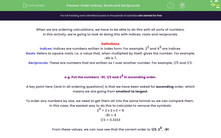When we are ordering calculations, we have to be able to do this with all sorts of numbers.
In this activity, we're going to look at doing this with indices, roots and reciprocals.
Definitions
Indices: Indices are numbers written in index form. For example, 22 and 43 are indices.
Roots: Refers to square roots, i.e. a value that, when multiplied by itself, gives the number. For example, √49 is 7.
Reciprocals: These are numbers that are written as 1 over another number. For example, 1/5 and 1/3.
e.g. Put the numbers √81, 1/3 and 23 in ascending order.
A key point here (and in all ordering questions) is that we have been asked for ascending order, which means we are going from smallest to largest.
To order any numbers by size, we need to get them all into the same format so we can compare them.
In this case, the easiest way to do this to calculate to remove the symbols:
23 = 2 x 2 x 2 = 8
√81 = 9
1/3 = 0.3333
From these values, we can now see that the correct order is: 1/3, 23, √81
In this activity, you will order a variety of numbers and expressions according to value, including indices, roots and reciprocals.








